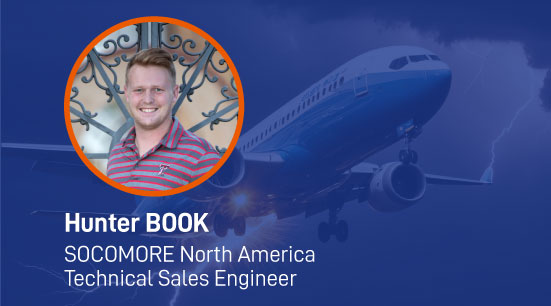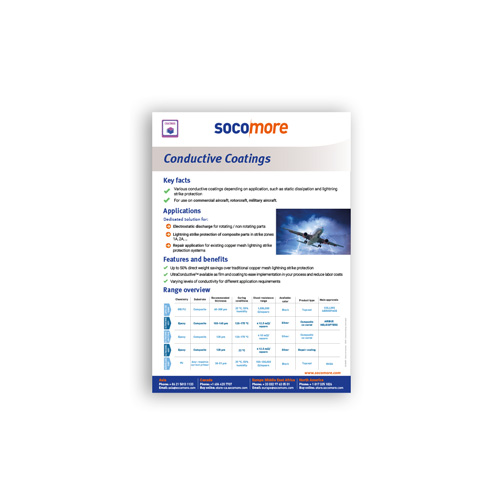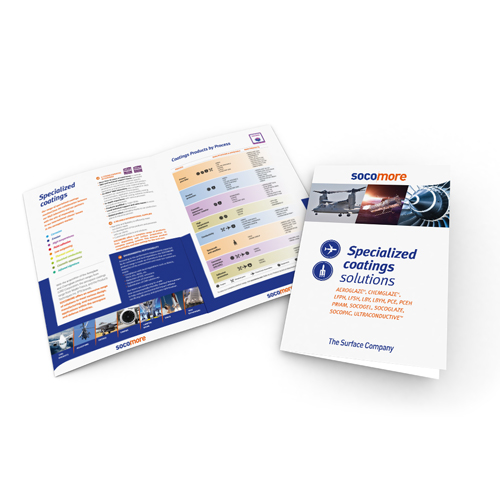Lightning strike protection (LSP) refers to measures taken to mitigate the damaging effects of lightning strikes on aircraft. LSP works by utilizing metals on the aircraft surface to provide a low resistance path for harmful lightning currents to safely dissipate into the environment. Additionally, LSP systems offer shielding to help protect sensitive electronics from electromagnetic interference (EMI) generated by lightning strikes and wireless technologies.


Optimizing Material Selection is Critical
Surface Material Requirements in Aerospace
The aerospace market requires surface materials that excel in 5 areas:
- electrical conductivity
- durability
- weight
- aerodynamics
- simplicity
Highly Conductive for Lightning Strike Protection
Surface Materials used in aircraft construction must be highly conductive, capable of withstanding and dissipating the immense energy from lightning strikes without compromise. This conductivity ensures that lightning's electrical current is safely redirected around the aircraft's hull and dispersed, protecting the structure, the sensitive electronic systems, and the passengers on board.
Chemically and Mechanically Resistant to Provide Durability
The ideal aerospace material must maintain its conductive properties over time, resisting corrosion and abrasion that could compromise its effectiveness.
This durability ensures long-term reliability and safety, reducing maintenance costs and extending the service life of the aircraft.
Lightweight for Cost Savings
Weight is a paramount concern in aerospace. Every kilogram added to an aircraft's structure has a ripple effect, impacting fuel efficiency, range, and payload capacity. Lightweight materials contribute to a more fuel-efficient and cost-effective operation.
Aerodynamically Efficient for Optimal Flight
The shape and texture of materials used on the aircraft's exterior directly affect air resistance, or drag, encountered during flight. Materials that offer a smooth, streamlined surface can significantly reduce drag, thereby improving the aircraft's performance.
Simplicity of Material to Reduce OEM and MRO Costs
Manufacturing and repairing composite materials at a high rate can be a very time consuming and expensive process. Simplifying material complexity helps cut costs by reducing the need for additional materials and the time required for integration into the composite system.
Limitations of Standard Solutions
The industry standard Expanded Copper Foil (ECF) systems offer high conductivity and durable material strength. However, they come with drawbacks such as increased weight, reduced aerodynamics, and added complexity and cost to the composite manufacturing and repair processes.
Ultraconductive Coatings for Aerospace: The Better LSP choice
Ultraconductive - Superior surface material for LSP Solutions
Ultraconductive offers an LSP solution that holds FAA approval and has been tested and approved for lightning strike zones 1a and 2a. This solution not only provides electrical conductivity and durability comparable to the standard ECF system but also provides weight savings, improved aerodynamics, and reduced complexity.
Ultraconductive maintains a resistivity <12mΩ and is capable of withstanding mechanical weathering, abrasion, and chemical exposure testing. At 140 g/sm or 2.9 lb/100 sq ft, Ultraconductive can offer up to a 50% weight savings compared with its competitors. The Ultraconductive spray or film provides a superior surface finish to ECF. This improvement not only enhances the aerodynamics of the aircraft but also reduces complexity and the requirement for additional surface smoothing layers in the composite system.
Simplified Manufacturing Process for Aerospace OEM
Manufacturing new composite materials at a high rate can be a very time consuming and expensive process.
As previously mentioned the application of the industry standard ECF requires additional surfacing film layers to improve the finish of the composite structure. ECF also fails to provide a simple application solution for complex parts or already finished composite parts.
The additional layers required to achieve a smooth composite finish, along with the extra time needed to fit ECF to complex parts, increase OEM labor costs and time expenditure.
SOCOMORE coatings are available in 2 forms:
- Ultraconductive Spray
- Ultraconductive Surfacing Film
Ultraconductive Spray requires no additional layer for surface smoothing and can be directly applied to the tool during the composite layup or directly to a finished part. Its spray form enables OEMs to leverage automation and robotics for application. Ultraconductive spray also provides a simple solution for coating complex and already finished parts, further reducing labor cost and time expenditure.
Furthermore, the Ultraconductive film material offers the simplicity of a single-layer LSP system without requiring additional spray equipment. This film can be applied by hand directly to the tool during the composite layup process.
Maintenance, Repair, and Overhaul (MRO) made easier
Complexity of ECF materials and additional surfacing layers also create challenges in the MRO process.
Current MRO processes necessitate a diverse array of materials and on-site equipment, as well as a sequence of steps to efficiently address post-lightning strike damage.
This encompasses various impregnated and non-impregnated ECF layers, multiple isolation layers, diverse resin types, and equipment for sanding, cutting, and material preparation. Additionally, it is common for repaired ECF to exhibit suboptimal performance in conductivity.
Our Ultraconductive line offers versatile solutions for repairing both itself and existing ECF materials:
- The Ultraconductive surfacing film can be easily cut into any shape and applied to repair areas with ease.
- Ultraconductive spray can be applied in varying thicknesses using spray equipment and cured with a heat blanket.
- For applications where heat is a concern, our Ultraconductive ambient temperature cure coating provides a room-temperature curing option, curing in just 4 hours.
- In all repair applications, we anticipate our Ultraconductive material to deliver superior and more consistent conductivity compared to ECF.
Enhanced EMI Shielding
In an ever growing wireless world the effects of EMI become greater in concern.
EMI is caused when electric waves used for radio, phone, or other wireless electronics affect the functionality of sensitive electronic circuits.
Shielding is used to protect the sensitive electronics from the external electrical signals. Shielding materials absorb or reflect the wireless electrical signals thus reducing the chance of interference.
In the aircraft industry ECF is typically used in the line of defense against the unwanted electrical signals.
Our Ultraconductive material has been shown to far outperform the standard ECF in our EMI shielding testing.
When applied to 3 ply of carbon Ultraconductive raised the shielding capability of the system to greater than 100dB at 1 GHz.
The material shows similar or even better performance between a range of 30 KHz and 10GHz.
Conclusion
SOCOMORE Ultraconductive coatings line for aerospace offers:
- Similar lightning strike protection and durability as industry standard ECF. Offering compliance with aerospace material standards and FAA regulations.
- Significant weight reduction in aerospace materials, contributing to fuel efficiency and environmental sustainability.
- Improvement in Aerodynamics, by improving surface finish and reducing drag to optimize aircraft performance.
- Simplification of the aerospace manufacturing process and MRO efficiency, ensuring cost-effective solutions for OEM and MRO sectors.
- Improvement in aircraft EMI shielding capabilities as compared to the standard ECF.
Ready to elevate your aerospace projects with our state-of-the-art Ultraconductive coatings? Contact us today to explore how we can make your aircraft lighter, safer, and more cost-efficient, all while adhering to the highest industry standards.
Would you like to know more about our conductive coatings?
Download our brochures to discover the whole range.











